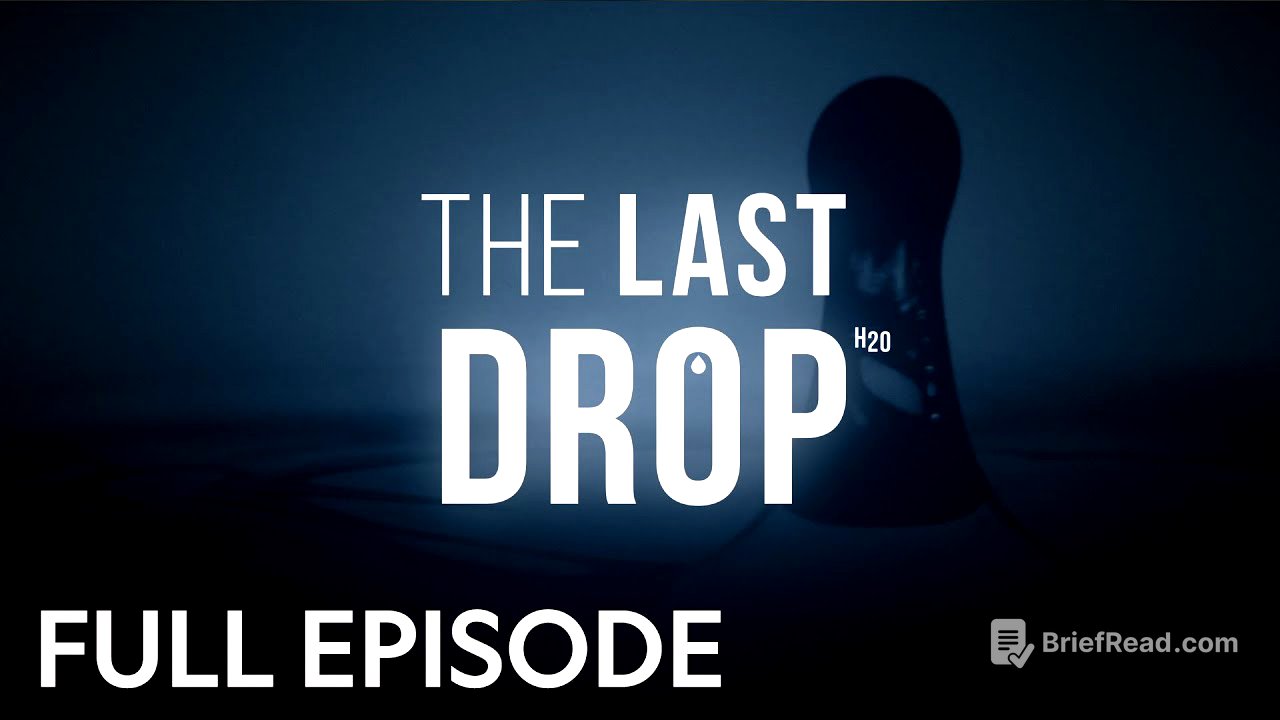TLDR;
This National Geographic documentary emphasizes the growing global water crisis and highlights potential solutions. It focuses on personal responsibility, agricultural innovations, and urban planning strategies to conserve and replenish fresh water resources. The journey spans from Los Angeles to the Colorado River, showcasing the impact of drought and the efforts to mitigate water scarcity.
- Personal water use can be significantly reduced through simple changes.
- Agriculture needs to adopt water-efficient practices and drought-resistant crops.
- Urban areas can implement water recycling and aquifer replenishment programs.
Intro: The Looming Water Crisis [0:06]
Fresh water is rapidly depleting, leading to a desperate fight to change our water-intensive habits. While experts are crucial, individual changes in daily life are also necessary to strike a balance between modern comforts and planetary health, ensuring we don't use up the last drop of fresh water.
Los Angeles: Personal Water Footprint [1:28]
Los Angeles, with over 10 million residents, faces critically low fresh water supplies after two decades of drought. To address this, an audit of personal water usage is conducted, revealing that while indoor water use is slightly below average, outdoor use is significantly higher due to the sprinkler system. Simple changes, like not rinsing dishes and installing water-saving devices, can make a big difference.
San Francisco Bay: Ecosystem Collapse [5:30]
The San Francisco Bay is experiencing an ecosystem collapse due to excessive fresh water diversion for agriculture and urban use. This diversion impacts endangered species like Chinook salmon and smelt, as the reduced fresh water inflow increases salinity, damaging the nursery habitat crucial for these fish. Addressing this water crisis is critical, especially for future generations.
Personal Changes and the Colorado River [9:35]
Simple changes at home, such as installing low-flow toilets and showerheads, and collecting shower water while it heats up, can significantly reduce water consumption. If everyone in the US cut their water use by 30%, it would save billions of gallons daily. The journey then shifts to the Colorado River, a vital water source for Nevada, Arizona, and Southern California.
Hoover Dam and the Colorado River's Stress [11:22]
The Hoover Dam is central to the water supply for 40 million people and vast farmlands. However, the Colorado River is under severe stress due to a 20-year drought, one of the driest periods in centuries. The reservoir has dropped 120 feet, revealing a "bathtub ring," indicating the severity of the water loss.
Las Vegas: Managing Water Scarcity [15:04]
Las Vegas manages to stay hydrated despite a mega-drought and millions of tourists annually. The city has implemented strict conservation measures, such as limiting grass in new homes and paying residents to remove lawns. Golf courses are also being transformed with technology to use recycled water efficiently.
Home Transformation: Sustainable Gardening [18:59]
Transforming a yard into a sustainable garden involves using native plants, building a swale and rain garden to capture rainwater, and directing groundwater back into the aquifer. This reduces water footprint and supports local ecosystems. Aquifers across the US are being depleted faster than they can replenish, making conservation crucial.
Tree Ring Research: Understanding Drought Patterns [21:38]
Tree ring research helps understand long-term drought patterns. Ancient trees provide data showing that current droughts, while severe, are not unprecedented. Past droughts have lasted for decades, emphasizing the need for sustainable water management.
Dietary Changes: Reducing Water Consumption [24:28]
Reducing meat consumption is a significant way to save water, as producing beef requires vast amounts of water. Chef Babette Davis promotes "hefetarianism," cutting meat consumption by half, making sustainable eating more accessible. Cattle farming contributes to deforestation and high water usage.
Arizona Agriculture: Adapting to Drought [27:57]
In Arizona, cotton, a water-intensive crop, is a major agricultural export. Farmer Brian Wong has shifted to less thirsty crops like white sonora wheat, reducing water use by nearly half. This grain is finding a local market, supporting sustainable agriculture.
Consumer Choices and Water Conservation [31:12]
Consumers have purchasing power to support water conservation. Choosing jeans made from organic cotton that use less water and reducing consumption of water-intensive products like smartphones can make a difference.
Phoenix: Turning a Desert into an Oasis [32:38]
Phoenix, the hottest city in the US, is turning wastewater into a resource by creating wetlands that replenish aquifers and support diverse wildlife. The city also banks extra Colorado River water, ensuring a sustainable water supply for the long term.
Home Rain Garden Project [35:42]
A home rain garden project involves redirecting water from the roof to a swale and infiltration tank, allowing it to soak into the soil and nourish plants. This helps replenish groundwater and creates a beautiful, sustainable landscape.
Returning Home: Hope for the Future [38:00]
Returning to the Bay Area, there's encouragement in seeing drought-tolerant yards and water-efficient practices. The journey highlights that changing mindsets and collective efforts can turn the tide on the water crisis, making it a good place to raise a family.
Completed Rain Garden and Hugel Culture [39:35]
The completed rain garden features meadow grasses and a hugel culture, a regenerative gardening technique using logs to create a spongy, soil-like environment. This system captures and retains water, supporting plant growth and reducing runoff.
Measuring the Impact: Water Reduction Results [41:47]
The challenge to reduce water use by 30% resulted in a 55% reduction, from just under 300 gallons per day to 136 gallons per day. This was achieved through simple changes like installing efficient appliances and creating a rain garden, demonstrating that significant water savings are possible without drastic lifestyle changes.
Conclusion: The Last Drop [43:19]
Less than 2% of the planet's water is clean, accessible fresh water. It's crucial to use water responsibly and sustainably. By changing our relationship with water in everything we do, we can ensure there's enough for everyone before we reach the last drop.
